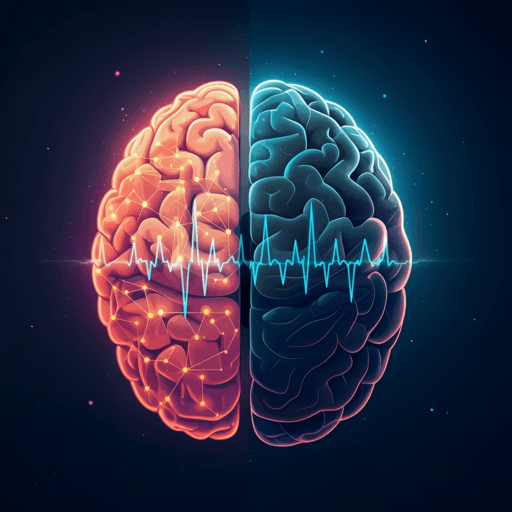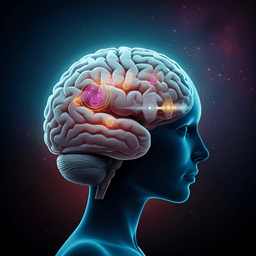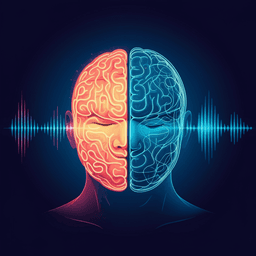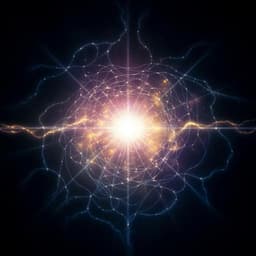
Medicine and Health
Motor learning promotes regionally-specific spindle-slow wave coupled cerebral memory reactivation
D. Baena, E. Gabitov, et al.
Sleep's slow wave–spindle (SW‑SP) coupling selectively reactivates motor memories in the hemisphere that learned the sequence, with reactivations time‑locked to coupled SW‑SP complexes in task‑critical areas, while uncoupled spindles recruit primary sensory regions and may support sleep maintenance. Research conducted by Daniel Baena, Ella Gabitov, Laura B. Ray, Julien Doyon, and Stuart M. Fogel.
~3 min • Beginner • English
Introduction
The study addresses how slow wave–spindle (SW-SP) coupling supports the reactivation and consolidation of motor sequence memories during sleep. Prior work shows sleep spindles (11–16 Hz) increase with motor skill learning and correlate with behavioral gains and changes in motor-related brain structures. Simultaneous EEG-fMRI has revealed brain activations time-locked to spindles and slow waves in thalamus, temporal lobe, cingulate, motor cortex, putamen, and hippocampus, suggesting reactivation. However, the specific contribution of SW-SP coupling (vs uncoupled events) to motor memory consolidation and its regional/hemispheric specificity remained unclear. The authors hypothesize that brain activations time-locked to SW-SP complexes would index memory reactivation in the striato-cerebello-cortical network (striatum, hippocampus, parietal cortex, cerebellum, motor cortex, thalamus), be stronger after motor learning vs control, and be lateralized to the trained (contralateral) hemisphere.
Literature Review
Spindles are a hallmark of NREM sleep and are linked to consolidation for both motor and declarative memories, with learning-dependent increases in spindle activity and correlations with performance. EEG-fMRI studies show regional activations time-locked to spindles/slow waves, including thalamus, temporal lobe, cingulate, motor cortex, putamen, and hippocampus. Past work from the authors showed reactivation of motor learning regions (e.g., striatum) time-locked to spindles predicting performance gains. Nishida and Walker reported regional specificity of spindles in the hemisphere engaged during unimanual learning. SW-SP coupling—where spindles nest within slow wave up-states—is considered a plasticity marker and has been associated with memory consolidation; recent findings suggest dissociable activations for coupled vs uncoupled events and coupling-dependent relationships with cognition. Yet, the role of SW-SP coupling in motor memory reactivation, and the functions of uncoupled spindles, had not been resolved.
Methodology
Design and participants: Two datasets were combined where appropriate (total N=31). Dataset 1 (N=12) included both an experimental night after motor sequence learning (MSL) and a control night (CTRL) after a motor control task, within-subject and counterbalanced one week apart. Dataset 2 (N=19) included only the MSL session. All participants were right-handed, healthy, with normal sleep, and screened to exclude psychiatric/neurological disorders and sleep disturbances; excessive caffeine/alcohol use, night shifts, recent time-zone travel, and specific expertise (e.g., professional typing/musicianship) were exclusionary. An acclimatization night in a mock scanner was required, and participants needed ≥5 minutes consolidated NREM sleep in a 2-hour window to proceed.
Tasks: The MSL task was a 5-item explicit finger-tapping sequence (4-1-3-2-4) performed with the non-dominant (left) hand using an MR-compatible 4-button pad. Training and retest consisted of 14 blocks (60 keypresses per block; 12 sequence repetitions), self-paced, with a 15-s rest between blocks. Performance metric: inter-keypress interval (IKI) on correct presses. Offline gains were assessed by comparing mean IKI of the last 4 training blocks to the first 4 retest blocks (Dataset 1) or to the single retest block (Dataset 2, behavioral data not presented). The CTRL task (Dataset 1 only) matched motor execution without sequence learning: simultaneous four-button presses at ~3 Hz (±0.25 Hz), left hand, with training/retest structure mirroring MSL.
Polysomnography and EEG processing: 64-channel MR-compatible EEG (Braincap MR; Brain Products) referenced to FCz; 5000 Hz sampling; additional ECG channels. Gradient artifacts were removed via adaptive average template subtraction; data downsampled to 250 Hz. Ballistocardiogram artifacts corrected using ECG R-peak guided adaptive subtraction; residuals addressed with ICA when needed. Signals were re-referenced to averaged mastoids and low-pass filtered at 60 Hz. Sleep stages were scored by an expert per AASM guidelines using the Counting Sheep PSG toolbox. Channels of interest for detection and coupling: Fz, Cz, Pz, C3, C4.
Event detection: Slow waves (N2/SWS) were detected using a band-pass (0.5–2 Hz; Chebyshev Type II filters, zero-phase) and period–amplitude criteria (peak-to-peak >75 µV; duration >0.25 s). Spindles (11–16 Hz) were detected using complex demodulation centered at 13.5 Hz (5 Hz bandwidth) with an adaptive amplitude threshold (99th percentile), followed by expert verification. Variables included integrated amplitude, duration, density; onset and peak times were extracted.
SW–spindle coupling: Spindles were marked as coupled if the spindle peak occurred within ±2 s (4-s window) around the slow wave negative peak (encompassing one cycle of a 0.5 Hz slow wave). Preferred phase (slow wave phase at spindle amplitude maximum) and coupling strength (mean vector length) were computed using CircStat; Rayleigh and V-tests assessed non-uniformity/preferred direction (up-state peak at 0°). Pz (fast spindle-dominant) and motor channels (C3/C4) were used a priori in fMRI analyses.
fMRI acquisition: 3T Siemens TIM TRIO, 12-channel head coil. T2*-weighted EPI: TR=2160 ms, TE=30 ms, FA=90°, FoV=220×220×132 mm, 40 axial slices, matrix 64×64×43, voxel size 3.44×3.44×3.0 mm, GRAPPA=2, 10% gap. Structural T1 MPRAGE: TR=2530 ms, TE=1.64/3.6/5.36/7.22 ms, TI=1200 ms, FA=7°, FoV=256×256×176 mm, 1×1×1 mm voxels.
Preprocessing and GLM: SPM12/DARTEL segmentation; skull stripping; realignment (6-parameter); coregistration to structural; normalization to MNI; resampling to 3 mm isotropic; 6 mm FWHM smoothing. Only motion-free NREM2/SWS volumes were analyzed. First-level fixed-effects GLMs modeled coupled and uncoupled slow waves (aligned to negative peaks) and coupled and uncoupled spindles (aligned to onsets) as stick functions convolved with HRF. Nuisance regressors: 6 motion parameters and first five CSF components via CompCor; 128 s high-pass filter; serial correlations modeled with AR(1)+white noise (ReML). Contrasts estimated main effects and comparisons among event types.
Group analysis and inference: Second-level random-effects one-sample t-tests and repeated-measures ANOVAs tested consistency across participants and conditions (post-MSL vs post-CTRL; coupled vs uncoupled). Whole-brain voxel-wise threshold p<0.005 (two-sided), followed by cluster-extent FWE control; small-volume correction applied to predefined ROIs. Visualization via Nilearn; labels via AAL. ROI parameter estimates extracted with MarsBar for follow-up stats.
Hemispheric analyses: To test lateralization from unimanual learning, BOLD responses time-locked to coupled SW–SP at contralateral (C4) vs ipsilateral (C3) motor cortex were compared (Dataset 1).
Key Findings
Behavioral evidence of learning and consolidation (Dataset 1, N=12):
- Performance improved across training blocks for the MSL task (one-way repeated-measures ANOVA: F(13,143)=6.48, p<0.001).
- Early rapid improvements: t(11)=2.667, p=0.022 (block 1→2); t(11)=2.853, p=0.016 (block 2→3).
- Overnight offline gains: faster IKI at retest vs end of training for MSL, t(11)=2.91, p=0.014; no gains for CTRL, t(11)=-1.31, p=0.214. CTRL IKI ~0.30 s (SEM 0.01) at end of training and ~0.31 s (SEM 0.001) at retest.
Coupling prevalence and phase relationship (Combined N=31):
- Mean per participant events: 366 coupled spindles (SEM=56) and 893 uncoupled spindles (SEM=95).
- Coupling phase: preferred spindle occurrence shortly before/around the slow wave up-state peak (0°) in 26/31 participants (V-test p<0.001); non-uniform preferred phase distribution in 26/31 (Rayleigh p<0.05).
Neuroimaging: Coupled SW–SP vs uncoupled events:
- Coupled SW–SP complexes (Pz; N=31) elicited widespread activation in motor-related regions (primary motor cortex, premotor cortex, supplementary motor area) overlapping with areas activated during MSL training (reactivation). Increased BOLD was lateralized to the trained (right) motor cortex/hand area, with additional activations in right thalamus and bilateral medial temporal lobe (including hippocampal/parahippocampal regions). No regions showed stronger activation during uncoupled slow waves.
- Isolated (uncoupled) spindles showed higher activation than SW–SP complexes in primary sensory cortices (somatosensory, primary auditory, primary visual), indicating a double dissociation between coupled (memory-related) and uncoupled (sensory-related) spindle events.
Task specificity (Dataset 1):
- Post-MSL vs post-CTRL sleep showed stronger activation time-locked to coupled SW–SP in bilateral thalamus, right parahippocampus, and superior anterior cerebellum (lobules IV–V), with clusters extending to occipital (calcarine, superior occipital, cuneus) and medial parietal (precuneus) regions, and additional medial superior parietal and prefrontal (superior/lateral) clusters. No regions were stronger post-CTRL vs post-MSL for coupled events. Uncoupled slow waves showed no learning-related differences.
Hemispheric specificity (Dataset 1):
- Contralateral (C4) analyses showed learning-related increases after MSL in precentral and postcentral hand knob regions, bilateral thalamus, cerebellum, occipital, and parietal lobes. No decreases post-MSL vs post-CTRL.
- Ipsilateral (C3) analyses showed limited increases (medial parietal/precuneus) and decreases in task-network regions (precentral gyrus, insular cortex), consistent with ipsilateral inhibition during reactivation.
Correlations:
- No significant correlations between coupled-event activation maps and behavioral improvements, likely due to limited sample size and retest data in combined analyses; nevertheless, contrasts were specific to learning night (post-MSL vs post-CTRL), supporting task specificity.
Overall: SW–SP coupling is the critical electrophysiological signature for regionally and hemispherically specific reactivation of motor memory networks during sleep, whereas uncoupled spindles preferentially recruit primary sensory systems, consistent with a sleep maintenance role.
Discussion
Findings support the hypothesis that SW–SP coupling mediates offline reactivation of motor memory networks in a regionally and hemispherically specific manner. Activations time-locked to coupled events overlapped with the MSL training network (motor cortex, SMA, cerebellum, striatum/putamen, medial temporal lobe), and were lateralized to the trained (contralateral) hemisphere, particularly the motor hand area—consistent with targeted reactivation of the memory trace. The hippocampus and putamen showed coupling-related engagement, aligning with models of hippocampo-neocortical dialogue and cortico-striatal reorganization during consolidation. In contrast, isolated spindles preferentially activated primary sensory cortices (somatosensory, auditory, visual), supporting a complementary sleep maintenance function by modulating sensory processing. The ipsilateral motor cortex showed deactivation post-MSL, suggesting active suppression that may enhance the specificity of contralateral reactivation. Together, these results clarify that the previously observed spindle-related reactivations and lateralization effects are primarily driven by SW–SP coupling rather than uncoupled events.
Conclusion
This study demonstrates that motor learning enhances regionally and hemispherically specific memory reactivation during sleep, time-locked to slow wave–spindle coupling. Coupled SW–SP complexes engage the trained hemisphere’s motor network and associated memory systems (thalamus, medial temporal lobe, putamen/cerebellum), consistent with a mechanism for consolidation via targeted reactivation. In contrast, uncoupled spindles preferentially recruit primary sensory regions, indicating a functional dissociation consistent with sleep maintenance. These findings refine the mechanistic understanding of sleep’s role in memory by pinpointing SW–SP coupling as a key electrophysiological signature of consolidation. Future work should (a) increase sleep/event sampling to dissociate fast vs slow spindles and NREM stage contributions, (b) design protocols to directly test the sleep maintenance role of uncoupled spindles (e.g., sensory perturbation paradigms), (c) address potential K-complex confounds, and (d) employ larger, repeated-measures cohorts to link individual differences in coupling-related reactivation to behavioral gains.
Limitations
- Limited sleep duration in EEG-fMRI constrained event counts and precluded separating fast vs slow spindles and differentiating NREM2 vs SWS contributions.
- Potential presence of K-complexes during N2 may confound slow oscillation interpretations.
- Binning events into coupled vs uncoupled reduced statistical power; some analyses could not include the combined dataset.
- A putamen cluster of interest fell below a conservative cluster-size threshold (K=30), though included based on strong a priori hypotheses.
- No significant brain–behavior correlations, likely due to limited participant numbers and retest measures (especially in Dataset 2 and combined analyses).
- Equal-contribution/senior-author notes (superscripts 5 and 6) are not affiliations; thus, additional institutional affiliations beyond those listed may not be fully captured.
Related Publications
Explore these studies to deepen your understanding of the subject.







